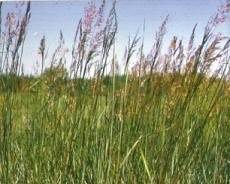
NPS Photo. Grasses have a number of adaptations that allow them to survive such conditions as drought, fire, heavy grazing, and frost. The bulk of a grass plant resides underground and is insulated by the soil, protecting the plant from sudden changes in temperature. The buds are also below the ground surface, which allows the plant to resprout its leaves after burning or grazing. Long roots permit the plant to draw water from deep below the ground surface. Grass plants are also able to enter long periods of dormancy during extreme heat or cold; the leaves appear dry and brown, only to green up again as soon as conditions become favorable. For these reasons, grasses have dominated the landscape in the erratic climate of the Great Plains for the past 8000 years. Southeastern Nebraska, with its abundant rainfall, was historically covered by tallgrass prairie, which requires more moisture than the shorter grasses that are present in the arid west. The tallgrass prairie ecosystem is highly diverse and provides food and cover for a variety of insects, birds, and mammals. Prairie soil is also extremely fertile, having been nourished for centuries by decaying plant material. For this reason, areas that were once tallgrass prairie are now some of the most productive agricultural lands in the world. This fact has contributed to the immense loss and fragmentation of the prairie habitat in the past 150 years. Less than 1% of the prairie remains in its historic state. Homestead National Historical Park is home to the second oldest restored tallgrass prairie in the nation. |
Last updated: February 27, 2021
